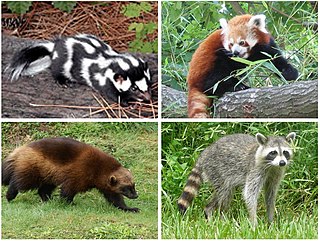 W
WCarnivora is an order of placental mammals that have specialized in primarily eating flesh. Its members are formally referred to as carnivorans, though some species are omnivorous, such as raccoons and bears, and quite a few species such as pandas are specialized herbivores. The word 'carnivore' is derived from Latin carō "flesh" and vorāre "to devour", it refers to any meat-eating organism. The order Carnivora is the fifth largest order of mammals and one of the more successful members of the group; it comprises at least 279 species living on every major landmass and in a variety of habitats, ranging the cold polar regions to the hyper-arid region of the Sahara Desert to the open seas. They come in a huge array of different body plans in contrasting shapes and sizes. The smallest carnivoran is the least weasel with a body length of about 11 cm (4.3 in) and a weight of about 25 g (0.88 oz). The largest is the southern elephant seal, with adult males weighing up to 5,000 kg (11,000 lb) and measuring up to 6.7 m (22 ft). All species of carnivorans are descended from a group of mammals which were related to today's pangolins, having appeared in North America 6 million years after the Cretaceous–Paleogene extinction event. These early ancestors of carnivorans would have resembled small weasel or genet-like mammals, occupying a nocturnal shift on the forest floor or in the trees, as other groups of mammals like the mesonychians and creodonts were occupying the top faunivorous niche. However, by the time Miocene epoch appeared, most if not all of the major lineages and families of carnivorans had diversified and took over this niche.
 W
WAiluridae is a family in the mammal order Carnivora. The family consists of the red panda and its extinct relatives.
 W
WCaniformia is a suborder within the order Carnivora consisting of "dog-like" carnivorans. They include dogs, bears, wolves, foxes, raccoons, badgers, seals and mustelids. The Pinnipedia are also assigned to this group. The center of diversification for Caniformia is North America and northern Eurasia. Caniformia stands in contrast to the other suborder of Carnivora, Feliformia, the center of diversification of which was in Africa and southern Asia.
 W
WCarnivoramorpha are a clade of mammals that includes the modern order Carnivora.
 W
WFeliformia is a suborder within the order Carnivora consisting of "cat-like" carnivorans, including cats, hyenas, mongooses, viverrids, and related taxa. Feliformia stands in contrast to the other suborder of Carnivora, Caniformia.
 W
WCarnivora is an order of placental mammals that have specialized in primarily eating flesh. Its members are formally referred to as carnivorans, though some species are omnivorous, such as raccoons and bears, and quite a few species such as pandas are specialized herbivores. The word 'carnivore' is derived from Latin carō "flesh" and vorāre "to devour", it refers to any meat-eating organism. The order Carnivora is the fifth largest order of mammals and one of the more successful members of the group; it comprises at least 279 species living on every major landmass and in a variety of habitats, ranging the cold polar regions to the hyper-arid region of the Sahara Desert to the open seas. They come in a huge array of different body plans in contrasting shapes and sizes. The smallest carnivoran is the least weasel with a body length of about 11 cm (4.3 in) and a weight of about 25 g (0.88 oz). The largest is the southern elephant seal, with adult males weighing up to 5,000 kg (11,000 lb) and measuring up to 6.7 m (22 ft). All species of carnivorans are descended from a group of mammals which were related to today's pangolins, having appeared in North America 6 million years after the Cretaceous–Paleogene extinction event. These early ancestors of carnivorans would have resembled small weasel or genet-like mammals, occupying a nocturnal shift on the forest floor or in the trees, as other groups of mammals like the mesonychians and creodonts were occupying the top faunivorous niche. However, by the time Miocene epoch appeared, most if not all of the major lineages and families of carnivorans had diversified and took over this niche.
 W
WThis is a list of estimated global populations of Carnivora species. This list is not comprehensive, as not all carnivorans have had their numbers quantified.
 W
WThis list contains terrestrial members of the order Carnivora with an average reported mass of 160 kilograms (350 lb) or more.
 W
WThis is a list of estimated global populations of Marsupials species. This list is not comprehensive, as not all Marsupials have had their numbers quantified.
 W
WMiacoidea is a paraphyletic superfamily that had been traditionally divided into two families of carnivores: Miacidae and Viverravidae. Miacoids were primitive carnivores that lived during the Paleocene and Eocene Epochs, about 66-33 million years ago. Today, Miacidae is recognized as a paraphyletic array of stem taxa that probably resulted in some "miacid" genera ending up just outside the order Carnivora, the crown-group within the Carnivoramorpha. Carnivoramorpha consists of both Miacoidea and Carnivora, but excludes the order Creodonta that existed alongside Carnivoramorpha. Miacoids are regarded as basal carnivoramorphs. The miacids are a paraphyletic group containing all miacoids that are not viverravids.
 W
WThe Mustelidae are a family of carnivorous mammals, including weasels, badgers, otters, ferrets, martens, minks, and wolverines, among others. Mustelids are a diverse group and form the largest family in the order Carnivora, suborder Caniformia. Mustelidae comprises about 56–60 species across eight subfamilies.
 W
WMusteloidea is a superfamily of carnivoran mammals united by shared characters of the skull and teeth. Musteloids share a common ancestor with the pinnipeds, the group which includes seals.